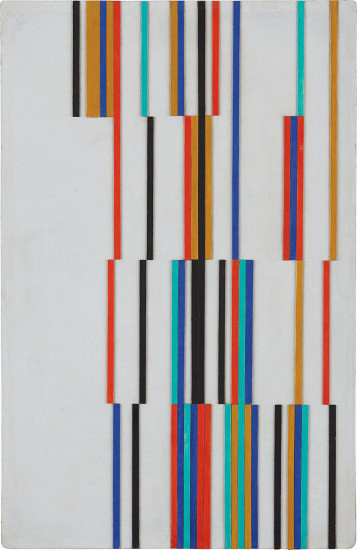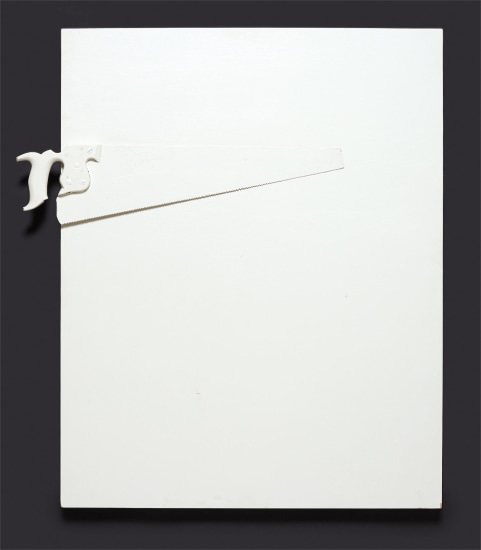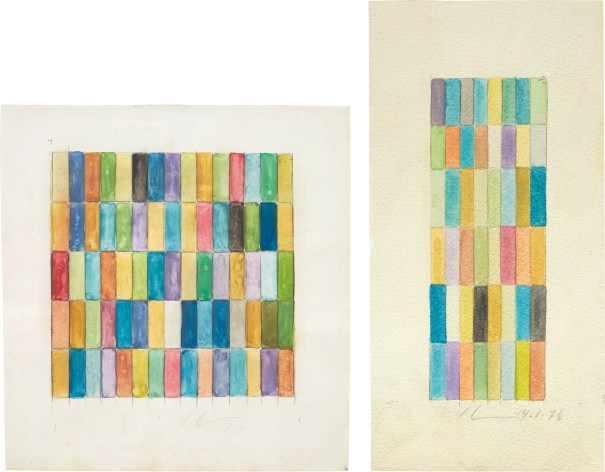Alejandro Otero Untitled 1984 painted strips of board applied to painted board 29 x 10 2/3 in. (73.7 x 27.1 cm) Signed and dated "Alejandro Otero 1984" on the reverse. This work is accompanied by a certificate of authenticity signed by Alejandro, Mercedes and Carolina Otero.
Provenance Gift from the artist to Mr. Ramón Casas Havana,1984 By descent to Private Collection, Havana Acquired from the above by the present owner Catalogue Essay Though Alejandro Otero is seen as one of the greatest Venezuelan abstract artists of the Post-War period, it would be amiss to look at this worthy distinction without fully understanding the immense impact the notions of integration and architecture had on his work. For Otero, painting was, as the scholar Juan Ledezma so accurately describes, “the site where a renovated conception of space would at first glance be forged and then projected out of the picture frame. Otero’s encounter with abstraction, the artist affirmed in order to dispel any doubts, amounted to an encounter with architecture”(J. Ledezma, “Beyond Positivism, Toward Integration: The Urban Geometries of Alejandro Otero and Carlos Raúl Villanueva ” in Resonant Space: The Colorhythms of Alejandro Otero Milan: Five Continents Editions, 2014, p. 39). In fact, there is no doubt that Otero’s oeuvre runs parallel to his collaboration with architect Raúl Villanueva and that projects such as the Residential Unit “El Paraíso” or the stained glass mosaics and murals produced for the Central University of Venezuela both informed and were influenced by his most important series such as the Ortogonales (1950), emColoritmos (1955-1960), and Tablones (1973 and onward). The question of integration between architecture, the lived experience, and art is fully evident in these series. It is a question which Otero sought to answer through the rhythmic notion inherent to so many of his works where white, brilliant colors, and black bands steadily resonate in a play of “retinal rivalry” between object, space, and the viewer’s gaze. The present lot is an emblematic example of these characteristics and can be seen as a scaled interpretation of, for example, the architectural integration of color and lines apparent in Mural Gemelo and the rhythmic beat of later Colorhythms works. Though this work is clearly informed by all of these previous influences there are both formal and historical aspects to Untitled that make it beautifully unique. Here black, yellow, aquamarine, blue, and red bands dance within a much broader field of white. Instead of functioning as an additional color, however, the white space here serves as the organizing element of the work. It allows the eye to flow downward, following each strip as it ends, and jumping when another one begins; extending the beat of colors through what can be imagined as an animated measure of a musical notation. Larger than a traditional boceto, yet more intimate than a full scale painting, the formica strips are painted with characteristic duco paint and laid on board instead of wood. The result is a work that is a perfect synthesis of painting, collage, and Otero’s lifelong dedication to experimenting with the spatial and optical effects of line and color. Furthermore, the piece counts with a unique historical trajectory and provenance. Gifted and dedicated by Otero to his dear friend Ramón Casas in Cuba in 1984 the work is not only witness to Otero’s personal life and travels, but also proof of the exchange between international artists and the politically and economically isolated Havana of the early 1980s. Read More Artist Bio Alejandro Otero Venezuelan • 1921 - 1990 Alejandro Otero is an important figure in Venezuelan abstract and kinetic art. He studied and lived in France and returned to Venezuela during a significant moment when his country was undergoing modernization. During this time he participated in a large scale architectural project with renowned Venezuelan architect Raúl Villanueva that significantly informed his works. Primarily influenced by Piet Mondrian his art denotes the notions of integration and architecture, as well as the continual experimentation with spatial and optical effects of line and color. His most important contribution to the field of
Alejandro Otero Untitled 1984 painted strips of board applied to painted board 29 x 10 2/3 in. (73.7 x 27.1 cm) Signed and dated "Alejandro Otero 1984" on the reverse. This work is accompanied by a certificate of authenticity signed by Alejandro, Mercedes and Carolina Otero.
Provenance Gift from the artist to Mr. Ramón Casas Havana,1984 By descent to Private Collection, Havana Acquired from the above by the present owner Catalogue Essay Though Alejandro Otero is seen as one of the greatest Venezuelan abstract artists of the Post-War period, it would be amiss to look at this worthy distinction without fully understanding the immense impact the notions of integration and architecture had on his work. For Otero, painting was, as the scholar Juan Ledezma so accurately describes, “the site where a renovated conception of space would at first glance be forged and then projected out of the picture frame. Otero’s encounter with abstraction, the artist affirmed in order to dispel any doubts, amounted to an encounter with architecture”(J. Ledezma, “Beyond Positivism, Toward Integration: The Urban Geometries of Alejandro Otero and Carlos Raúl Villanueva ” in Resonant Space: The Colorhythms of Alejandro Otero Milan: Five Continents Editions, 2014, p. 39). In fact, there is no doubt that Otero’s oeuvre runs parallel to his collaboration with architect Raúl Villanueva and that projects such as the Residential Unit “El Paraíso” or the stained glass mosaics and murals produced for the Central University of Venezuela both informed and were influenced by his most important series such as the Ortogonales (1950), emColoritmos (1955-1960), and Tablones (1973 and onward). The question of integration between architecture, the lived experience, and art is fully evident in these series. It is a question which Otero sought to answer through the rhythmic notion inherent to so many of his works where white, brilliant colors, and black bands steadily resonate in a play of “retinal rivalry” between object, space, and the viewer’s gaze. The present lot is an emblematic example of these characteristics and can be seen as a scaled interpretation of, for example, the architectural integration of color and lines apparent in Mural Gemelo and the rhythmic beat of later Colorhythms works. Though this work is clearly informed by all of these previous influences there are both formal and historical aspects to Untitled that make it beautifully unique. Here black, yellow, aquamarine, blue, and red bands dance within a much broader field of white. Instead of functioning as an additional color, however, the white space here serves as the organizing element of the work. It allows the eye to flow downward, following each strip as it ends, and jumping when another one begins; extending the beat of colors through what can be imagined as an animated measure of a musical notation. Larger than a traditional boceto, yet more intimate than a full scale painting, the formica strips are painted with characteristic duco paint and laid on board instead of wood. The result is a work that is a perfect synthesis of painting, collage, and Otero’s lifelong dedication to experimenting with the spatial and optical effects of line and color. Furthermore, the piece counts with a unique historical trajectory and provenance. Gifted and dedicated by Otero to his dear friend Ramón Casas in Cuba in 1984 the work is not only witness to Otero’s personal life and travels, but also proof of the exchange between international artists and the politically and economically isolated Havana of the early 1980s. Read More Artist Bio Alejandro Otero Venezuelan • 1921 - 1990 Alejandro Otero is an important figure in Venezuelan abstract and kinetic art. He studied and lived in France and returned to Venezuela during a significant moment when his country was undergoing modernization. During this time he participated in a large scale architectural project with renowned Venezuelan architect Raúl Villanueva that significantly informed his works. Primarily influenced by Piet Mondrian his art denotes the notions of integration and architecture, as well as the continual experimentation with spatial and optical effects of line and color. His most important contribution to the field of







.jpg)




.jpg)
.jpg)
Try LotSearch and its premium features for 7 days - without any costs!
Be notified automatically about new items in upcoming auctions.
Create an alert